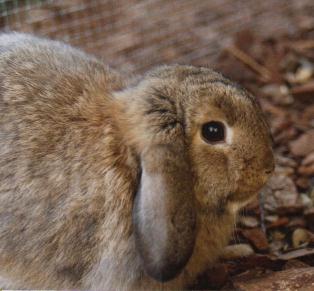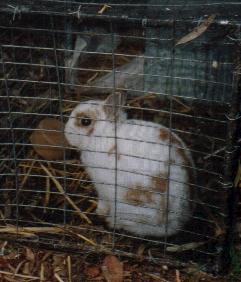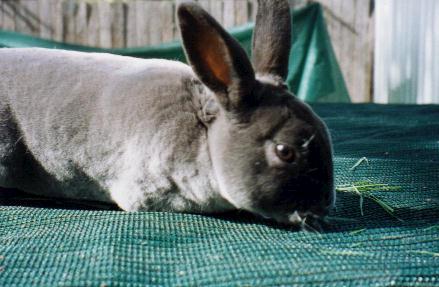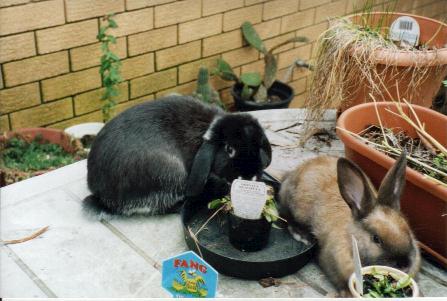History - Rabbits
I never had a
rabbit when I was growing up in
I was always mixing and
matching them and surprisingly, in view of conventional wisdom and later
observation, there were no fights. Aurelia did get a bit stroppy with her
original companions but I put her in with Lepidus and Fabiola, who were firm
friends, and they sat on her - literally - which took a lot of the ginger out
her and the trio were the three musketeers. Fabiola was a cheeky little minx
who would chase the Oriental out of the yard - this was a cat who took little
from his own species and not much from humans, either but Lops bothered him
something chronic. Fabiola was the devil to get back inside once she was out to
play in the yard, too, scampering under bushes and darting off, one ear up and
one ear down ("propeller-head" I used to call it) just when you
thought you had caught her. One morning my mother who was visiting looked out
the kitchen door and asked, "Is that a rabbit on the back deck?" Sure
enough, Fabiola had invited herself to breakfast, having escaped her run.
Lepidus was one of the nicest natured, gentlest rabbits I have ever known. Even
though an entire buck 12 months old when I got him, he would look after the
younger rabbits like a surrogate father.
Alas, in early November of
that year, Fabiola, Lepidus, Aurelia, Genkuro and Shiratama were all killed in
a matter of minutes while playing in an open pen by a Malamute who got into the
garden while I went into the house to get something. Drusus escaped by leaping
out of the enclosure and getting out the side gate while Claudius saved himself
by going to ground in a half-completed burrow the does had been constructing. I
collared the brute and sent it to the pound. The owner claimed it had never
done such a thing before but got out while her back was turned. She was oh so
sorry at the time but soon changed her tune and never did pay me even the
pittance she haggled down to. For this reason, I always advise that if you are
ever in this unfortunate situation, do not negotiate but go through the courts
as you have the right to do. Too many people have no honour or sense of right
and responsibility.
However, there was one good
thing that did come out of this horrible experience and that was I discovered
the world of the rabbit fancy. In attempting to fill the void by buying some
more bunnies, I found a notice for a show out at Hall put on by the Canberra
Rabbit Club. I bought a Black Otter Netherland Dwarf doe because she looked
like a miniature Aurelia. Thereafter I would go to the shows when I knew they
were on, just to look at the rabbits, chat to people and occasionally buy some
more.
In 1997 I bought my first
pedigree, rung rabbit, a two year old Agouti Cashmere Lop doe named Camilla.
She was a Bonreiki rabbit and came not only with papers but information on
joining the Canberra Rabbit Club, which I duly did. Christine was very helpful,
answering questions I had about rabbits and offering to mate Camilla if I
wanted to breed from her. I wasn't so sure about that as in January that year
Clodia had taken matters into her own paws and presented me with an unexpected
litter while visiting a friend in the
 Any career Camilla might have had on
the show table was cut short a week after I got her when Scipio, who had
hitherto accepted her as a companion in his run (he was by now desexed)
suddenly turned on her and tore both her ears. Scipio was sin-binned (and got
bailed up and bitten by the pet guinea pig Yuki as mentioned in The Pig and I), then given away to some people who
didn't have any other rabbit.
Any career Camilla might have had on
the show table was cut short a week after I got her when Scipio, who had
hitherto accepted her as a companion in his run (he was by now desexed)
suddenly turned on her and tore both her ears. Scipio was sin-binned (and got
bailed up and bitten by the pet guinea pig Yuki as mentioned in The Pig and I), then given away to some people who
didn't have any other rabbit.
Camilla was a definite
character, very much "Queen Camilla" she lived for a while indoors
and chinned everything animate and inanimate - my chair, my carpet, my Siamese
cat, my table… She later shared a run with the second Lepidus. a
 My first rung rabbit which I bought
specifically for showing was Alpine Fabius, a Netherland Dwarf buck. He was an
My first rung rabbit which I bought
specifically for showing was Alpine Fabius, a Netherland Dwarf buck. He was an
 A little later in 1998 I bought the first
Calpurnia, a Siamese Sable Mini Rex doe who did very well in the kitten and
junior classes but dipped out once she reached adulthood as a lot of white
hairs turned up in her coat. At that time not many people were breeding Mini
Rex and there was only a limited range of colours. I mated her to Gail's
handsome Black buck, Hunter a couple of times and kept a lovely Blue doe from
the first litter, who had the densest coat I had come across. Shame about her
white whiskers. Eventually disillusioned by the limited colours, and the faults
in the lines I seemed to be working with (open coats, sudden deaths of kits as
late as 9 weeks and so on), I sold my Mini Rex in early 1999.
A little later in 1998 I bought the first
Calpurnia, a Siamese Sable Mini Rex doe who did very well in the kitten and
junior classes but dipped out once she reached adulthood as a lot of white
hairs turned up in her coat. At that time not many people were breeding Mini
Rex and there was only a limited range of colours. I mated her to Gail's
handsome Black buck, Hunter a couple of times and kept a lovely Blue doe from
the first litter, who had the densest coat I had come across. Shame about her
white whiskers. Eventually disillusioned by the limited colours, and the faults
in the lines I seemed to be working with (open coats, sudden deaths of kits as
late as 9 weeks and so on), I sold my Mini Rex in early 1999.
The third major addition to
the rabbitry in 1998 were the Dwarf Lops. As noted above, I had had a few as
pets but the first rung ones came from Danica Stud, a Marten Sable buck I named
Cornelius Merula and a Black Otter buck I named Valerius Messala. Only problem,
as the boys could attest, there wasn't a doe to be had for love nor money
anywhere apart from the somewhat persnickety Domitilla. Towards the end of the
year Christine came to the rescue with two Bonreiki does, Fleur (Blue), and her
daughter, Valeria (Black). I have bred quite a few of them, sold a number as
pets or to other breeders. Later on, I reduced the numbers to concentrate on
the Satins, parting rather reluctantly with Reguli Faustus, a sooty fawn who
has done very well on the show bench, and Reguli Sabina, a seal-point with a
very friendly nature, and good show career but the world's worst mother. After
selling off some non-performers (the drought over the past six years has played
havoc with the breeding program – they simply won’t), I have decided to focus
on Tan-pattern Lops.

Not to be forgotten was
Scribonia, a Petite Sooty Fawn Satin doe I bought as a pet (though she was
rung) as the breed fascinated me and the second Lepidus, a Danica Cashmere Lop
bought for the same reason.
Also in 1998 I registered
the stud name and had a metal shed put up as a rabbitry. The only problem was
where to get cages. I looked at the set ups various breeders had and was told
you could get secondhand cages but as I don't own a trailer (don't even have a
tow-bar on the Ford Festiva hatchback) they were out of the question.
Eventually I put an ad in the Canberra Times asking for a person to make
cages which was answered by a fellow who makes small animal cages which are
sold in various local pet shops. Finally I had a banks of cages and could move
the rabbits in out of their pens in the yard (some were in the commercially
available metal runs, others were in converted wooden children's playpens and
yet others were in arrangements of garden lattices lashed together). Not a
moment too soon as we had a bad outbreak of myxomatosis in Dec. 1998 and going
into the new year.
In 1999 I acquired Rojeana
King, a two year old Castor Satin buck and decided to breed Satins. The only
problem was that Scribonia, though having a lovely colour and good
satinisation, lacked density in her coat so later in 2000 I obtained an Ivory
doe, Rojeana Mummie, who had a lovely dense coat. Their daughter, Reguli
Calpurnia, an Opal, did well on the show bench though was somewhat reluctant to
have babies though when she did she looked after them. King eventually
developed an abscess which never quite healed and he died, followed about a
year later by Mummie. The other Satin bucks I had never bred so I sold all but
Calpurnia as pets. Of her last litter, an Opal doe went to
In 2001 I decided to breed
Standard Rex instead of just admiring them as I had two nice Rojeana bucks, one
Castor one
Then I decided to breed
Dutch, first using Millennium Maximus who was originally acquired for displays
but has done well on the show bench. As the club’s breeders of Dutch seem have
disappeared again, I wanted to save this lovely breed from vanishing from
Similarly with the
British
Giant. From being BritGi Central, all of a sudden
In 2006 I acquired some
Chinchilla Gigantas. That is to say, they might more accurately described as
chinchilla-coloured Flemish Giants as that is their background. I have had a
couple of litters from them. They are a work in progress as I need to darken
the top coat and reduce the white triangle on the nape. Still they are very
attractive (chinchilla has always been one of my favourite rabbit colours) with
soft silky coats and they are of the right size to take an ‘L” ring not an ‘H’
ring. This is another breed that needs to be kept going (it also really needs
to be recreated like the French Lop). I kept one doe, Silver Dollar, from these
litters as she had the best colour and have mated her back to her father,
Silver Spar.
I have now got some Dwarf Lops again (the buck I got a few years ago then another Orange buck in 2013 and a doe) as I want to breed Orange. So that makes three breeds.